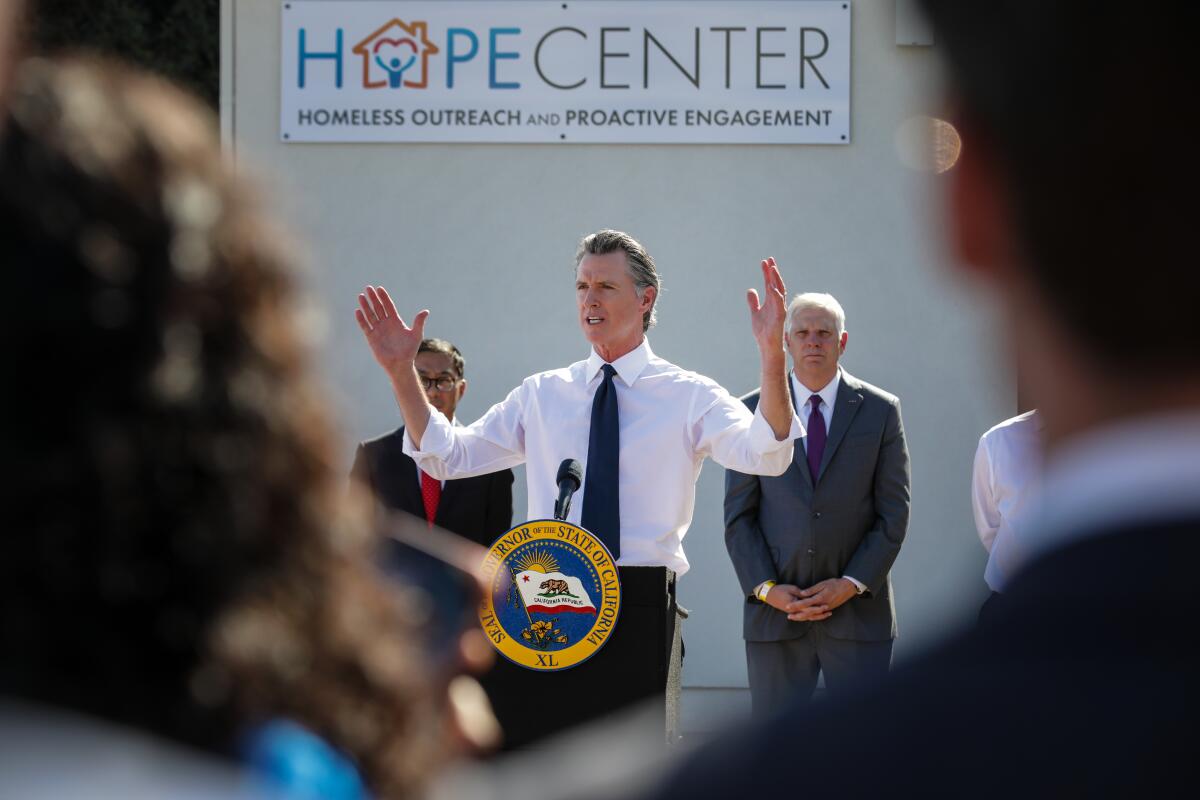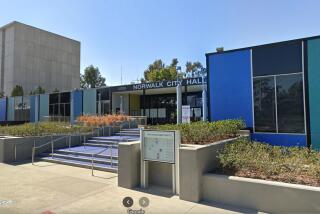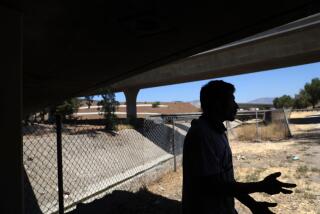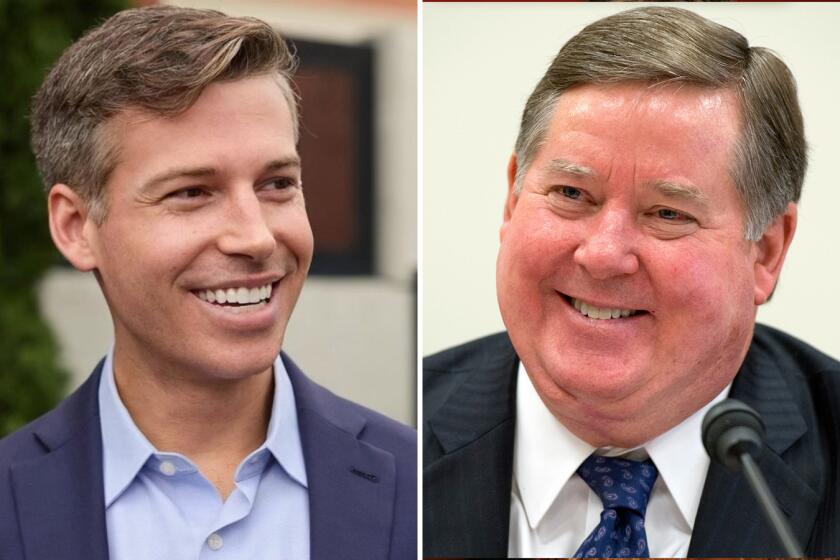Column: Newsom rejects every local homeless plan in state, demanding more ambition

Gov. Gavin Newsom is as frustrated and exhausted as the rest of us when it comes to homelessness in the Golden State. But as much as we’re fed up with suffering on the streets, he knows we’re also fed up with promises.
“We’re demoralized by our own lack of performance,” he told me Wednesday from the top floor of his office in Sacramento, overlooking a city as overrun with tents and despair as any in California.
“We’re at a point of moral crisis and a crisis of confidence in our leadership, as Democrats, as progressives,” he said. “Walk in any community in the state and tell me where we’re at the level we need to be.”
On Thursday, Newsom hopes to shake up both our dissatisfaction and the status quo by rejecting every local homeless action plan in the state, demanding more intensity when it comes to getting people off the streets and into homes. It’s a move that comes a few days before an election that, while the governor himself is under little threat, has seen the condition of California’s streets used on a national scale as proof that blue state policies are failing.
“I’m taking accountability,” Newsom, who is not running for president, said. “I love this state. It breaks my heart the people just trashing us.”
But, he acknowledged, “They’re right.”
Rejecting the homeless action plans is a move that’s largely symbolic — but sometimes symbolism is compelling and authoritative. Sometimes it’s all you’ve got, and this is a bit of both.
Newsom is sending an unexpected but clear message that the relationship between the state and local entities is about to change when it comes to homelessness. He seems genuinely willing to jump onto that third rail of politics, local control — similar to what the administration has done in cracking down on places that refuse to build their fair share of affordable housing. In that instance, the state is no longer rubber-stamping plans for state-mandated housing goals, but enforcing its rules and increasing goals.
If need be, he said, he’ll be the “mayor of California,” in places that can’t or won’t do it themselves — a sentiment that is going to throw down “a bit of a gauntlet” and make a lot of people angry (including mayors and other politicians who are “actually friends, like some of our friends that come over for the holidays”).
What’s at stake is a delay in the next big round of funding that cities, counties and continuums of care are expecting — roughly at least $600 million set to be divided among 75 governments and service providers that applied for the grant money, either alone or in groups.
Each of those applicants sent in a plan not just on how they would spend it, but goals for addressing underlying causes of homelessness, including creating housing. It’s those blueprints that the governor is sending back because he doesn’t believe they go far enough, fast enough.
Taken together, the plans promised to lower unsheltered homelessness in the state by only 2% over the next few years, because so many more people are expected to fall into homelessness. For every one person housed, two people become homeless in California. In the Bay Area, it’s three, by some estimates.
With that background, the plans collectively would have a net impact of reducing the number of people living on the streets by only about 2,000 in a state with more than 160,000 currently homeless people, about 70% of whom are outside. At the same time, since the start of the COVID-19 pandemic, the state has provided about $15 billion to cities and counties to fight homelessness.
Newsom said that, when he sat down to review the plans a few weeks ago, he began sorting them out into ones that were good and held the kind of “resourceful mind-set” he wants, and ones that were downright troubling — one applicant that included a partnership among multiple entities promised to not allow homelessness in its area to grow by more than 71%.
“I thought it was a typo,” he said. But it wasn’t.
Even in this dark blue state, there’s a surprising amount of contention about how to solve homelessness. Newsom has largely left it to local governments to figure out what works for them, giving money with few strings.
But there is an intense not-in-my-backyard pushback on nearly every project, in every city, and it’s becoming untamable for some local politicians. Time and again, people agree that the current situation is untenable and something’s got to give — as long as they’re not the ones who have to give it.
Faced with that hostility, there’s been a real lack of enthusiasm from some local governments to tackle homelessness with aggressiveness — or sometimes with even mild gusto. That failure to act has been compounded by confusion and buck-passing among jurisdictions and providers that often won’t work together or can’t figure out how to effectively collaborate.
Infighting has made it nearly impossible to solve this catastrophe.
Oakland is an example, one called out by the governor this spring for its haphazard and contentious approach to clearing one of the largest encampments in California, known as Wood Street. Wood Street included about 200 people living on Caltrans land in unhealthy and dangerous conditions that local authorities seemed to have little will to address. Newsom took his entire Cabinet to Wood Street this year and personally helped clean it up, a signal, he said, that the local powers needed to get their act together.
At one point, the city tried to argue that the state should provide services to those living in the encampment because it was state-owned land, prompting the governor to send a scathing letter reminding officials that “there is no such thing as a ‘resident of Caltrans,’ as the city’s position suggests.”
“Deliver damn results,” Newsom said Wednesday, speaking in general of his expectations.
“It’s a crisis. Act like it. Everybody step up,” he continued. “I’m not the mayor. You want me to come in? I’ll do the job. I’ll do it. Happily. I’ve been going into cities cleaning up encampments. Has anyone gotten the hint? If someone did that to me when I was mayor, I’d be like, ‘OK, I got it.’”
Despite that ire, it remains much easier, as the tony town of Woodside did this year to avoid affordable housing requirements, to creatively skirt responsibility rather than own the problem. The San Mateo County enclave declared itself a mountain lion sanctuary and claimed that building housing would harm the cats.
The homeless action plans, a new requirement for the state funding this year, were meant to address that disconnect between expectation and realization. Newsom said he intends to call all those would-be grantees together in a few weeks and push them to push themselves, holding the money back until they come up with goals that will get more people into shelter and more people into permanent housing.
But sending the plans back to the drawing board also has some practical purpose. In reality, the way the funding law is written means the state doesn’t have much power to oversee how the money is spent.
Understanding the state’s homeless funding scheme is a bit like putting together Ikea furniture, but the money withheld by holding up the action plans is basically the third round, out of an expected five, of the Homeless Housing, Assistance and Prevention program, which has been around only for a couple of years. Those grants, and a predecessor, have distributed about $1.6 billion of state money already, much from the flush general fund.
Local leaders will probably be quick to point out that while Newsom’s move sounds grand, it doesn’t address their real-world concerns. Chief among those is that HHAP funds are one-time money, meaning that the cash is meant to be given out for a few years, not forever. It’s hard for cities and counties to plan for permanent programs when the funding could disappear, especially with the economy nearing a recession.
Newsom is also going to receive pushback that some of the HHAP money — about 18% — is given only to jurisdictions that meet stated goals. Why put in ambitious goals when lowering the bar a bit could get you millions? That’s not sound policy. And there’s the fact that many HHAP dollars are already allocated to existing programs, making it hard to stretch them in new directions.
To all of that, Newsom says he’s “exhausted by the excuses.”
With that tension, this do-over may also represent a pragmatic last chance before Newsom has to ask the Legislature to tie strings to future allocations so the money can be better controlled at the state level.
Because whether this gambit brings the results we all want and need, Newsom knows he’s “the piñata” when it comes to responsibility, as he put it.
And we’re exhausted by excuses too.
More to Read
Sign up for Essential California
The most important California stories and recommendations in your inbox every morning.
You may occasionally receive promotional content from the Los Angeles Times.











